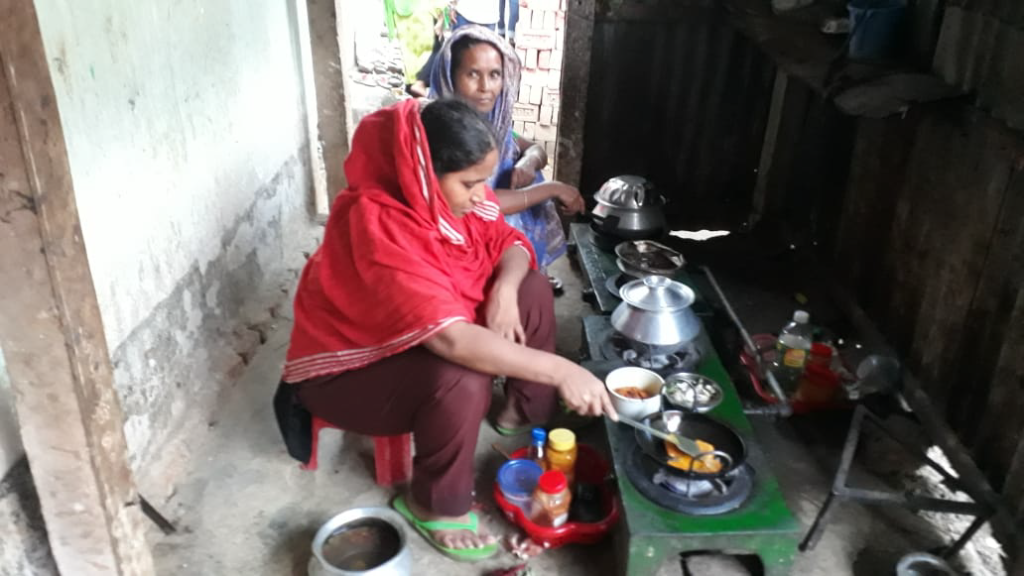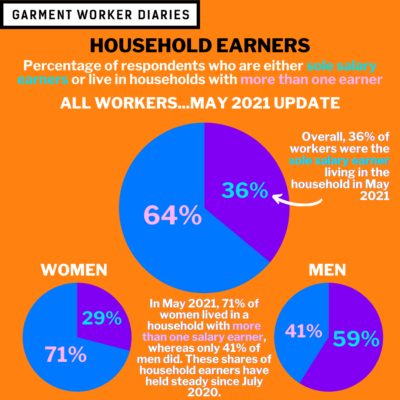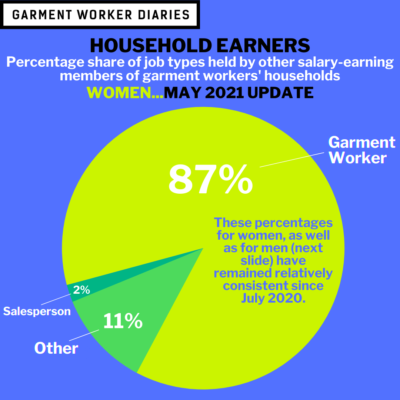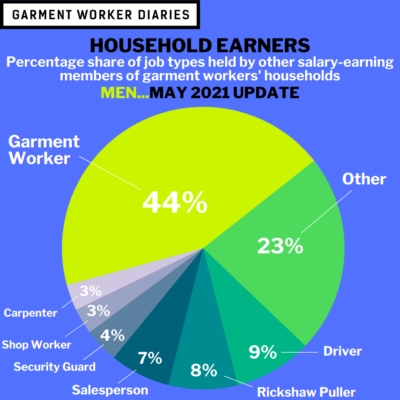For our most recent #OpenDiaries post, we asked garment workers in Bangladesh, “How do you take care of your loved ones?”. Respondents shared with us the many ways they do this: cooking for their loved ones, paying them visits, phoning them, nursing them when ill. And of course many respondents also told us that they assist their loved ones monetarily. As one garment worker put it, “I give all of my salary to my mother so that she can spend it as she wishes.” Another garment worker told us “My husband and two sons are my loved ones. I help my husband by adding my salary to the family savings plus taking care of them with him.”
For those respondents in the study who live in households with more than one salary earner, being able to add to the collective spending power is likely an important attribute, and for some, many or even all of those workers it could also be a source of pride.
Let’s now bring the Garment Worker Diaries’ household earner data up to date through the end of May 2021.
Note: Banner photo courtesy of garment workers in Bangladesh; numbers in graphs may not sum to 100% due to rounding
Household Earner Work Hours, Wages and Demographics
In May 2021 the proportion of garment workers in our study who were the sole household earner was very similar to our previous data updates: 36% of garment workers were the sole household earner in May 2021 compared to 35%, 33% and 34% in March 2021 and December and July 2020, respectively.
Among the 64% of respondents who weren’t the sole household earner, 84% of those other household earners gave their consent allowing our respondents to discuss those other earner(s)’s household finances with MFO and SANEM (about the same percentage as had given consent in preceding months). The employment rate of 94% among those other household earners in May 2021 was only a bit lower than in prior reporting periods (98%, 97% and 96% in March 2021 and December and July 2020, respectively). The median hours worked by other household earners in May 2021 was very similar to prior months: 244 hours in May 2021 compared to 240 hours in March 2021 and 243 and 239 hours in December and July 2020, respectively).
The median salary earned by other household earners in May 2021 was also very nearly the same as previously reported: Tk. 10,000 in May 2021 compared to Tk. 10,500 in March 2021 and Tk. 10,000 in both December and July 2020. The median salary for women has been identical in all reporting months so far: Tk. 10,000. Meanwhile, the median salary for men has continued to vary slightly: Tk. 10,300 and Tk. 11,000 in May and March 2021, respectively, and Tk. 10,000 and Tk. 9,000 in December and July 2020, respectively.
The demographic makeup of the other household earners and the share of job types remained very consistent in May 2021 compared to past reporting months. One possible trend to note is that the percentage of garment workers who are reporting that one of the other household earners is their spouse has continued to increase little by little over the last four reporting periods. This could perhaps be an indication that the overall employment rate in Bangladesh is also continuing in the right direction, or, it could be an indication of some other type of household organization trend.
Proportional Breakdown of Other Household Earners
|
Household Member |
May 2021 |
March 2021 |
December 2020 |
July 2020 |
|
Spouse |
77% |
76% |
74% |
71% |
|
Son |
5% |
5% |
6% |
5% |
|
Brother |
4% |
4% |
5% |
6% |
|
Father |
5% |
5% |
5% |
6% |
|
Mother |
3% |
3% |
3% |
4% |
|
Sister |
3% |
3% |
3% |
6% |
|
Daughter |
2% |
2% |
2% |
2% |
|
Other |
1% |
1% |
1% |
1% |
|
Brother-in-law |
0% |
0% |
0% |
0% |
|
Cousin |
0% |
0% |
0% |
0% |
Proportional Breakdown of Other Household Earner Job Types
|
Type of Job |
May 2021 |
March 2021 |
December 2020 |
July 2020 |
||||||||
|
Overall |
Women |
Men |
Overall |
Women |
Men |
Overall |
Women |
Men |
Overall |
Women |
Men |
|
|
Garment Worker |
52% |
87% |
44% |
50% |
89% |
41% |
51% |
87% |
42% |
51% |
87% |
42% |
|
Driver |
8% |
0% |
9% |
7% |
1% |
9% |
7% |
0% |
9% |
5% |
0% |
7% |
|
Carpenter |
2% |
0% |
3% |
3% |
0% |
3% |
2% |
1% |
3% |
3% |
0% |
3% |
|
Salesperson |
6% |
2% |
7% |
6% |
0% |
7% |
6% |
0% |
8% |
5% |
0% |
7% |
|
Shop Worker |
3% |
0% |
3% |
4% |
0% |
6% |
4% |
0% |
5% |
2% |
0% |
3% |
|
Rickshaw Puller |
6% |
0% |
8% |
6% |
0% |
7% |
5% |
0% |
6% |
7% |
0% |
9% |
|
Security Guard |
3% |
0% |
4% |
2% |
0% |
3% |
3% |
0% |
4% |
3% |
0% |
4% |
|
Other |
21% |
11% |
23% |
21% |
10% |
24% |
22% |
12% |
24% |
23% |
13% |
26% |
The household earner data presented here come from interviews conducted over the phone from July 2020 through May 2021 with a pool of 1,297 workers. These workers are employed in factories spread across the five main industrial areas of Bangladesh (Chittagong, Dhaka City, Gazipur, Narayanganj, and Savar). Just over three-quarters of the working respondents are women, roughly representative of workers in the sector as a whole.



